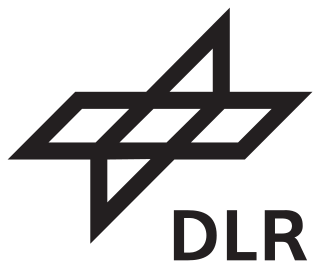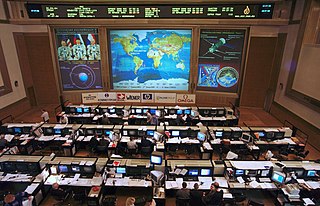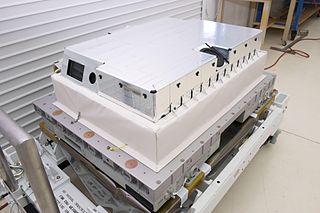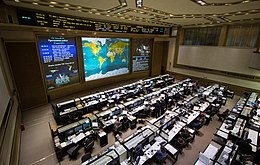
The European Space Operations Centre (ESOC) serves as the main mission control centre for the European Space Agency (ESA) and is located in Darmstadt, Germany. ESOC's primary function is the operation of uncrewed spacecraft on behalf of ESA and the launch and early orbit phases (LEOP) of ESA and third-party missions. The Centre is also responsible for a range of operations-related activities within ESA and in cooperation with ESA's industry and international partners, including ground systems engineering, software development, flight dynamics and navigation, development of mission control tools and techniques and space debris studies.

Columbus is a science laboratory that is part of the International Space Station (ISS) and is the largest single contribution to the ISS made by the European Space Agency (ESA).

The Automated Transfer Vehicle, originally Ariane Transfer Vehicle or ATV, was an expendable cargo spacecraft developed by the European Space Agency (ESA), used for space cargo transport in 2008–2015. The ATV design was launched to orbit five times, exclusively by the Ariane 5 heavy-lift launch vehicle. It effectively was a larger European counterpart to the Russian Progress cargo spacecraft for carrying upmass to a single destination—the International Space Station (ISS)—but with three times the capacity.

The German Aerospace Center is the national center for aerospace, energy and transportation research of Germany, founded in 1969. It is headquartered in Cologne with 35 locations throughout Germany. The DLR is engaged in a wide range of research and development projects in national and international partnerships.
Oberpfaffenhofen is a village that is part of the municipality of Weßling in the district of Starnberg, Bavaria, Germany. It is located about 23 km (14 mi) from the city center of Munich.

OHB SE, headquartered in Bremen, is a European space and technology group specializing in the development and implementation of complete space systems, the production of components for various launcher programs as well as the operation of satellite systems and the processing and provision of the data collected. The company employs over 3,000 people at 15 locations in ten countries, most of them in Europe.

Flight controllers are personnel who aid space flight by working in such Mission Control Centers as NASA's Mission Control Center or ESA's European Space Operations Centre. Flight controllers work at computer consoles and use telemetry to monitor various technical aspects of a space mission in real-time. Each controller is an expert in a specific area and constantly communicates with additional experts in the "back room". The flight director, who leads the flight controllers, monitors the activities of a team of flight controllers, and has overall responsibility for success and safety.

Thales Alenia Space is a joint venture between the French technology corporation Thales Group (67%) and Italian defense conglomerate Leonardo (33%). The company is headquartered in Cannes, France.

The year 2010 saw a number of notable events in worldwide spaceflight activities. These included the first test flight of the SpaceX Dragon commercial resupply spacecraft, which is intended to resupply the International Space Station (ISS), and the maiden flights of the Falcon 9 and Minotaur IV rockets. In June 2010, South Korea conducted a second Naro-1 launch, after the failure of the rocket's maiden flight in 2009; however, the second attempt also failed. The Kosmos-3M was retired from service, making its final flight in April. The Molniya-M was also retired from service, making its final flight in September.

The Columbus Control Centre also known by its radio callsign, Mission Control Munich, is the mission control centre which is used to control the Columbus research laboratory, which is part of the International Space Station (ISS). The control centre is located at the German Aerospace Center (DLR) facility in Oberpfaffenhofen near Munich, Germany. The centre is operated by the DLR, under contract from the European Space Agency (ESA).

The Jules Verne ATV, or Automated Transfer Vehicle 001 (ATV-001), was a robotic cargo spacecraft launched by the European Space Agency (ESA). The ATV was named after the 19th-century French science-fiction author Jules Verne. It was launched on 9 March 2008 on a mission to supply the International Space Station (ISS) with propellant, water, air, and dry cargo. Jules Verne was the first of five ATVs to be launched.

The International Space Station programme is tied together by a complex set of legal, political and financial agreements between the fifteen nations involved in the project, governing ownership of the various components, rights to crewing and utilisation, and responsibilities for crew rotation and resupply of the International Space Station. It was conceived in September 1993 by the United States and Russia after 1980s plans for separate American (Freedom) and Soviet (Mir-2) space stations failed due to budgetary reasons. These agreements tie together the five space agencies and their respective International Space Station programmes and govern how they interact with each other on a daily basis to maintain station operations, from traffic control of spacecraft to and from the station, to utilisation of space and crew time. In March 2010, the International Space Station Program Managers from each of the five partner agencies were presented with Aviation Week's Laureate Award in the Space category, and the ISS programme was awarded the 2009 Collier Trophy.

The US Orbital Segment (USOS) is the name given to the components of the International Space Station (ISS) constructed and operated by the United States National Aeronautics and Space Administration (NASA), European Space Agency (ESA), Canadian Space Agency (CSA) and Japan Aerospace Exploration Agency (JAXA). The segment consists of eleven pressurized components and various external elements, almost all of which were delivered by the Space Shuttle.

The European contribution to the International Space Station comes from 10 members of the European Space Agency (ESA) and amounts to an 8% share in the programme. It consists of a number of modules in the US Orbital Segment, ATV supply ships, launchers, software and €8 billion.

Nanoracks LLC is a private in-space services company which builds space hardware and in-space repurposing tools. The company also facilitates experiments and launches of CubeSats to Low Earth Orbit.

Optical Payload for Lasercomm Science (OPALS) is a spacecraft communication instrument developed at the Jet Propulsion Laboratory that was tested on the International Space Station (ISS) from 18 April 2014 to 17 July 2014 to demonstrate the technology for laser communications systems between spacecraft and ground stations.

High Definition Earth Viewing (HDEV) cameras were a payload package delivered to the International Space Station on the SpaceX CRS-3 Mission, launched on April 18, 2014. The High-Definition Earth Viewing camera suite was carried aboard the Dragon spacecraft and is configured on a platform on the exterior of the European Space Agency's Columbus laboratory module. It was the first large unpressurized NASA experiment to be assigned for delivery to the International Space Station by SpaceX. The system is composed of four commercial high definition video cameras which were built to record video of the Earth from multiple angles by having them mounted on the International Space Station. The cameras streamed live video of Earth to be viewed online and on NASA TV on the show Earth Views. Previously-recorded video now plays in a continuous loop on public streaming sites.

The German Space Operations Center is the mission control center of German Aerospace Center (DLR) in Oberpfaffenhofen near Munich, Germany.

SpaceX CRS-23, also known as SpX-23, was a Commercial Resupply Service mission to the International Space Station, successfully launched on 29 August 2021 and docking the following day. The mission was contracted by NASA and was flown by SpaceX using the Cargo Dragon C208. This was the third flight for SpaceX under NASA's CRS Phase 2 contract awarded in January 2016. It was the second mission for this reusable capsule.
The German space programme is the set of projects funded by the government of Germany for the exploration and use of outer space. The space programme is run by the German Aerospace Center, who conduct research, plan, and implement the programme on behalf of the German federal government.




















